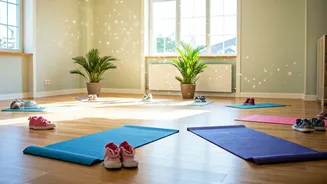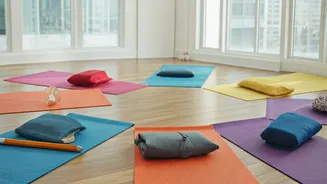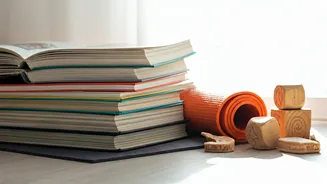Introduction: Yoga for Kids
Yoga, often perceived as an adult activity, can be remarkably beneficial for children. Introducing yoga at a young age offers a multitude of advantages,
extending beyond mere physical exercise. Regular practice nurtures crucial cognitive functions, playing a significant role in improving memory and concentration. Furthermore, yoga fosters a sense of self-awareness and body coordination in kids, helping them develop better emotional regulation and a calmer approach to daily life. These yoga asanas are easily integrated into daily routines, making them a practical and enjoyable tool for overall child development. These routines provide engaging and practical tools for enhancing both physical and mental well-being.
Mountain Pose (Tadasana)
Tadasana, or Mountain Pose, is an excellent starting point for any yoga session. This foundational pose helps kids develop balance and body awareness. To perform Tadasana, have the child stand tall with feet together, arms relaxed at their sides. They should engage their core muscles, lengthen their spine, and imagine they are as tall as a mountain. This pose enhances focus and grounding, setting a positive tone for the entire yoga practice. Encourage children to visualize themselves as strong and steady, just like a mountain. Doing so facilitates a sense of mindfulness, which greatly benefits concentration and mental stability.
Tree Pose (Vrksasana)
Vrksasana, or Tree Pose, challenges children's balance while promoting focus. Instruct the child to stand on one leg, placing the sole of the other foot either on the inner thigh or calf of the standing leg, avoiding the knee. Arms can be raised overhead like branches. Encourage the child to look at a fixed point to maintain balance. Tree Pose strengthens leg muscles and develops coordination. This asana also enhances concentration as kids strive to stay balanced and centered. The combination of physical posture and mental concentration makes Tree Pose highly effective for improving focus.
Warrior Pose (Virabhadrasana)
Virabhadrasana, the Warrior Pose, comes in multiple forms, each offering distinct benefits. Begin with Warrior I, having the child step one foot forward, bend the front knee over the ankle, and extend arms overhead. This pose builds strength, confidence, and determination, all of which are essential for mental focus. Encourage the child to look forward, maintaining a steady gaze and envisioning themselves as a strong warrior. Warrior poses are not only physically stimulating but also instill a sense of courage. Consistent practice cultivates mental resilience and helps kids remain focused even when faced with challenges.
Downward Dog (Adho Mukha Svanasana)
Adho Mukha Svanasana, or Downward-Facing Dog, is a rejuvenating pose that stretches the entire body. From a hands and knees position, have the child lift their hips, forming an inverted 'V' shape. This pose improves blood flow to the brain, enhancing mental clarity. Downward Dog can reduce stress and fatigue, which directly benefits concentration and memory. Encourage the children to try to keep their back straight and arms extended and take deep breaths. The pose provides a gentle inversion, stimulating the mind and promoting a sense of calm, making it ideal for preparing the brain for learning and focus.
Cobra Pose (Bhujangasana)
Bhujangasana, or Cobra Pose, is a gentle backbend that opens the chest and stimulates the mind. Have the child lie on their stomach, place their hands under their shoulders, and lift their upper body, keeping the lower body grounded. Cobra Pose improves posture and energy levels, both of which are critical for staying focused. Encourage a slow, controlled movement and deep breathing. This pose increases concentration through a combination of physical activity and mindful breathing. Moreover, the chest-opening nature of the pose can promote a sense of confidence and mental clarity, crucial elements for focused learning.
Bridge Pose (Setu Bandhasana)
Setu Bandhasana, the Bridge Pose, is a gentle backbend that energizes the body. Instruct the child to lie on their back, bend their knees, and place their feet flat on the floor close to their hips. They should then lift their hips off the ground, supporting their weight with their shoulders and feet. Bridge Pose stretches the spine and stimulates the thyroid gland, which boosts energy levels and cognitive function. The pose can relieve mild stress and improve concentration. This asana also gently stretches the back and opens the chest, facilitating better blood circulation and enhancing focus.
Child's Pose (Balasana)
Balasana, or Child's Pose, is a calming pose that encourages relaxation and stress relief. The child should kneel, then fold forward, resting their forehead on the floor and arms extended forward or alongside the body. Child's Pose helps to quiet the mind and reduce anxiety, promoting better focus. It provides a chance to pause and reconnect with the breath. Taking a few moments in Child's Pose can clear the mind and sharpen focus. Encourage them to close their eyes and focus on the feeling of relaxation. This pose is particularly effective in resetting the mind and preparing it for enhanced concentration.
Seated Twist (Ardha Matsyendrasana)
Ardha Matsyendrasana, or the Seated Twist, enhances spinal flexibility while promoting concentration. Have the child sit with legs extended, bend one knee, and place the foot on the opposite side of the extended leg. Twist the torso towards the bent knee, holding onto the knee or thigh. The twist invigorates the spine and stimulates the digestive system, which can positively impact overall energy levels and focus. Twisting poses boost circulation, ensuring the brain receives adequate oxygen, and leading to improved memory and attention. This pose helps bring balance and focus into the mind and body.
Boat Pose (Paripurna Navasana)
Paripurna Navasana, or Boat Pose, strengthens the core and improves balance, both of which are essential for cognitive function. The child should sit with knees bent, lean back slightly, and lift their feet off the ground, balancing on the sitting bones. Boat Pose builds core strength and improves mental focus. This pose helps develop discipline and concentration as the child strives to maintain balance. Focusing on breath and core engagement helps to calm the mind and improves cognitive abilities. Practicing Boat Pose can sharpen both the body and the mind, and increase the ability to focus for extended periods.











